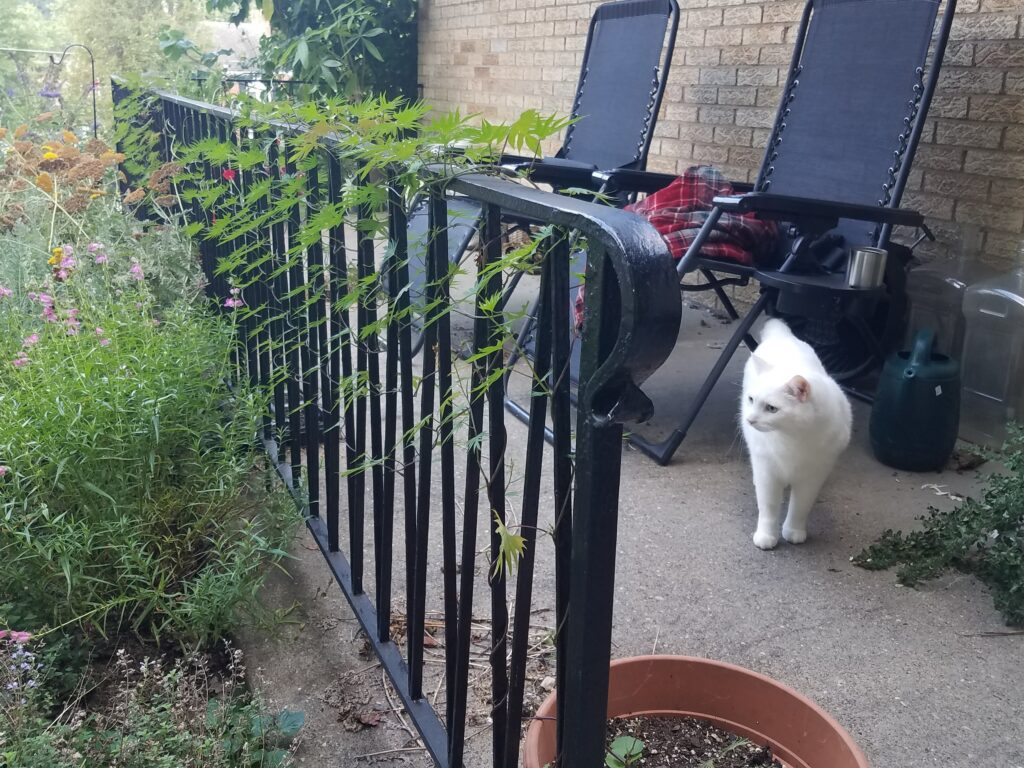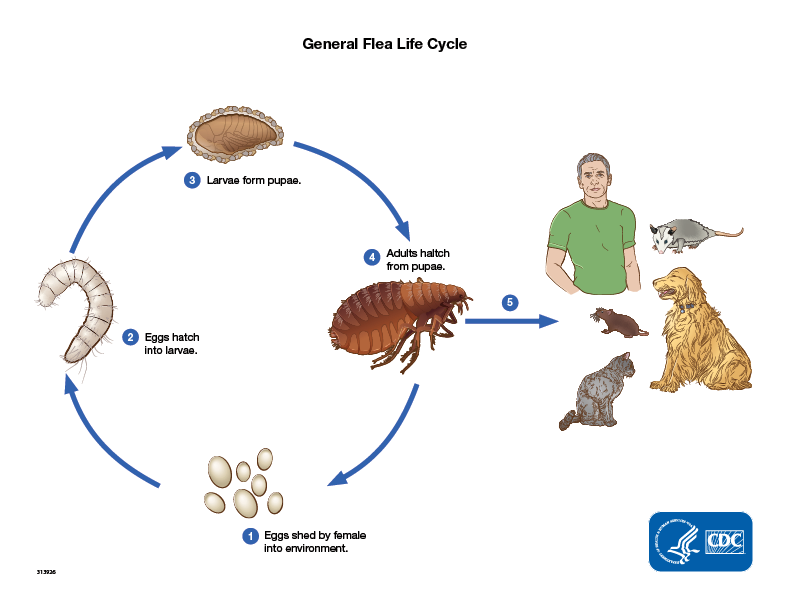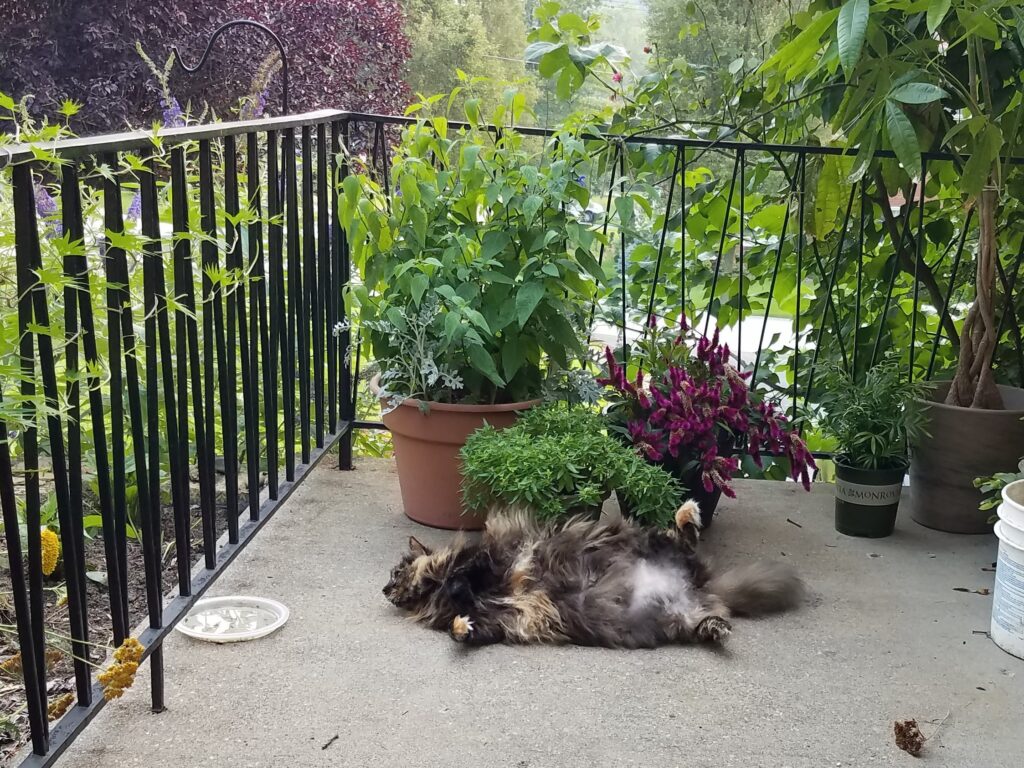Mark but this flea, and mark in this,
How little I knew about fleas …
because I thought indoor cats couldn’t get them. (Apologies to John Donne.[1])
At Siegfried’s vet appointment earlier this summer, the vet and I talked about a bare spot on his back near the base of his tail, where he had groomed most of his hair away. He had been doing it for some time, but not consistently. When we first noticed it last year, I purchased some bitter spray to discourage licking in the area. It helped a little bit, and his hair even grew back over the winter, but the issue started up again this spring. We went back to the bitter spray, but no one was a fan of it because I had to tackle him to administer it, and he and I both usually wound up with some in our mouths. I was also concerned that we were addressing a symptom and not a cause.

A Surprise Diagnosis
I had assumed that he was stress grooming. His step-sister Pumpkin has never forgiven Siegfried or me for moving into her house, but she mostly takes it out on Siegfried (probably because I feed her). When I told the vet that I thought it was a stress response to living in constant fear of attack, she told me that stress grooming is often the last explanation after multiple other possibilities have been ruled out. Based on where he had licked his hair away (and broken the skin in some places), she said the most likely explanation was fleas.
Now, I grew up in a family where cats are people. No, scratch that. In my family, cats are above people, to be worshiped and served. We never missed vet appointments, and we never skimped on necessary care. That’s not to say we didn’t walk into vet appointments with a critical eye toward anything that could be an upsell on expensive elective services. And one of those things that we always rolled our eyes at was the suggestion that our indoor cats should get flea medication.
And when I say “indoor cats,” that definition is a little flexible. Our kitties go out onto our front porch sometimes – only when we are there to watch them, and not into the yard. They love going outside to sit with me as I write my blog or water my plants. I was still under the impression that since they weren’t going out into the grass or garden, they weren’t coming into contact with anything other than the bees, moths, and smaller pollinators that come up onto the porch. And that is a possibility – since I do so much gardening, I could have been bringing fleas into the house on my clothes, in which case the kitties might be exposed even without their porch time.

Image credit: [2]
Although the vet didn’t find any fleas on Siegfried, she said that the location and appearance of what he was doing could very much be the result of even one flea bite. The seasonality of the issue also supported that idea, since he was fine over the winter but then started licking again in the spring when we were all going out more. We put him on flea medication, and within a few weeks, he didn’t appear to be itchy anymore; within a month, his hair was growing back. Pumpkin’s vet appointment got delayed because of a possible COVID exposure, but we were able to get her on flea medication the following month. Her vet did find one flea during her appointment.
Know Thy Enemy
I was surprised by the whole situation, but everything I read online has confirmed overwhelmingly that indoor cats can get fleas, most commonly in the following ways:
- Other animals that go in and out (like dogs) can bring them in; these other animals can include rodents, if you have mice in your house (which we occasionally do)
- Humans (either those who live there or those who are visiting) can bring them along when coming into the house
- If cats travel to other places for visits (the vet, boarding, trips to see friends and family), they can get them (or bring them) there [3]
Over 90% of fleas found on both dogs and cats are a specific type of “cat flea,” called Ctenocephalides felis felis. They undergo a four-stage life cycle consisting of egg, larva, pupa, and imago (or adult) and can live for up to two years. Adults must consume blood to be able to reproduce, and adult females are capable of laying up to 8,000 eggs, though most living on a host only make it to about 100 before their inevitable demise. The eggs are not sticky, and most roll off of the host animal to land in soil or carpet, hatching within two to seven weeks, depending on temperature and humidity. Larvae feed on organic matter but thrive on the feces of adult fleas until they are ready to spin a cocoon for the pupal stage. Pupae transform over the course of a week, but they can enter a state of semi-dormancy if conditions are not right to find a host. When an adult finally emerges from its cocoon, it can jump to a host and begin feeding within minutes.[4]

We were given a topical flea medication to try at home to see if that alleviated the grooming problem. Topical flea medications commonly work through a pesticide that paralyzes adult fleas. The medication needs to be applied between the cat’s shoulder blades, where they can’t immediately lick it off. It will be distributed across their skin through natural oils within a few days, and it lasts for about a month.[5]
The Best Defense…
However, there are concerns about the side effects of these types of medication. I haven’t looked into oral medication at all, but there are instances of severe side effects with topical medication – skin irritation, vomiting or diarrhea, even seizures and death – particularly when these medications aren’t used as directed. Most importantly, only cat treatments should be used on cats, and you should be very clear about your cat’s weight and the appropriate dosage. (This was particularly apt information, as Siegfried has just dropped below 15 pounds for the first time since I’ve had him.)[6]
Medication concerns aside, it’s important to point out that since some topical treatments are designed to work only on adult fleas, the length of the flea’s lifecycle is generally longer than one month, and very little of the flea’s life is actually spent on a host animal, topical medication cannot be the only measure taken. I will admit that a few weeks after Pumpkin got her first dose, I discovered a small cluster of itchy bug bites on my own ankle. It could have been something from outside, but I’m not going to rule out the possibility that it was our unwelcome guests looking for food that they could no longer get from either cat.

Image credit: [7]
In addition to flea treatments (and there are some natural options, which we have not tried [8]), regular cleaning of areas where they might be found is a necessary step. That means washing blankets and pet bedding in hot water and vacuuming soft surfaces, such as carpets and furniture. Take particular care in areas where your kitties typically like to spend their time.[9]
~
I hope with the small number of culprits found (just one to date) and some quick action, we will be able to address this annoyance before it becomes an issue. It will be nice to have a winter reprieve to do a little more research into some of our alternative options as well.
Have you dealt with fleas in your home? What worked well for you and your pets?
Thanks for reading!
[1] https://www.poetryfoundation.org/poems/46467/the-flea
[2] https://www.cdc.gov/fleas/life_cycle_and_hosts.html
[3] https://www.petmd.com/cat/5-ways-indoor-cats-can-get-fleas
[4] https://en.wikipedia.org/wiki/Cat_flea
[5] https://www.hillspet.com/pet-care/healthcare/flea-and-tick-treatments-oral-topical
[6] https://urbananimalveterinary.com/event/adverse-reactions-to-spot-on-flea-and-tick-products/
[7] https://knowyourmeme.com/photos/1181795-dune
[8] https://www.thesprucepets.com/home-remedies-for-fleas-on-cats-4580388
[9] https://www.healthline.com/health/healthy-home-guide/how-to-get-rid-of-fleas#pet-flea-removal
0 Comments